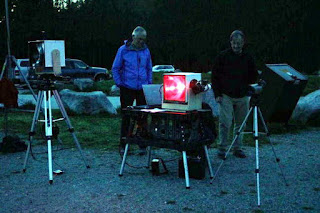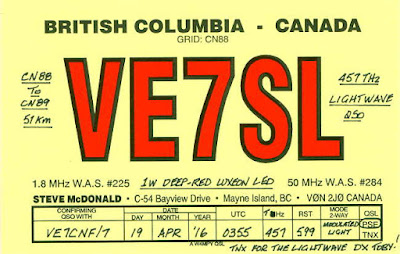Posts Tagged ‘lightwave’
 The G3XBM Experimental Blogs
The G3XBM Experimental Blogs
 |
| G3XBM's 5W Earth-Mode Tx (courtesy: G3XBM) |
My interest of late has been piqued by the ongoing VLF experimental work by several European amateurs.
Recalling that Roger, G3XBM, did some VLF experimenting a few years ago, I have been reviewing some of the excellent hands-on information gathered and published in his ham radio blog and to some of his other VLF pages.
It's not the first time that I have found project-inspiring reading within Roger's blogs. They really are a treasure-trove of useful information, construction notes and accumulated test data gathered from his methodical approach to so many interesting topics ... experimental amateur radio at its very best.
A few years ago I was immediately hooked by his experimental lightwave work, both line-of-sight and clear-air / cloudbounce scatter ... so much so that I also became involved in some lightwave work with other locals who were also inspired by Roger's information, culminating in our own West Coast Lightwave Adventure.
Roger's VLF experiments are also proving hard to resist, especially those of the earth-mode type and I may find myself falling victim to his detailed Sub 9kHz Amateur Radio pages and the Earth Mode pages in particular.
It seems that most amateur VLF work is being done in the vicinity of 8kHz since this part of the frequency spectrum is unassigned. I gather that one can conduct earth-mode tests in any portion of the VLF spectrum since no signal is being 'radiated' as is typically done via antennas. Further investigation remains to see if I need a 'developmental licence' to conduct some radiated (non-earth-mode) experiments in the 8kHz range as well.
Getting a VLF signal from here on Mayne Island across Georgia Strait via earth-mode or via conventional methods would make an interesting challenge and would certainly result in some new homebrewing opportunities.
 |
| courtesy: https://www.google.ca/maps |
Here on the island, I often hear audio associated with the container terminal and ship-loading operations near Tsawwassen, directly across the strait from here. I feel that this may be aided somewhat by the solid sandstone of the island being directly connected to the other side, so perhaps an earth-mode system utilizing the ocean as one-leg of a buried loop might be an interesting experiment to tackle ... or groundwave transmissions across the ocean via an antenna, to the other side, providing I could find someone to listen.
I see just two Canadian amateurs experimenting on VLF ... VO1NA (Joe) and VA3VVV (John) near Toronto. Any VE3's in the area who are interested in VLF may wish to contact John and exchange notes. He has a Facebook page showing his VLF setup. Interestingly, Joe's 30W VLF signal on 8.270 kHz has just crossed the Atlantic! Joe is documenting his VLF experiments here.
All of G3XBM's VLF blogs can be downloaded for reading or for printing via this link. Similarly, his lightwave experiments can all be found here ... both links will yield several pages of material if you click on the 'Older Posts' link at the bottom of each page.
The best way to follow these is chronologically which requires going all the way to the end of the final 'OlderPost' link and follow along with Roger as he gradually develops, evaluates and improves the gear that he needs to make progress. This is fascinating reading.
But be suitably warned ... you may readily fall victim to his experimental work as well and suddenly find yourself with another exciting project!
 The G3XBM Experimental Blogs
The G3XBM Experimental Blogs
 |
| G3XBM's 5W Earth-Mode Tx (courtesy: G3XBM) |
My interest of late has been piqued by the ongoing VLF experimental work by several European amateurs.
Recalling that Roger, G3XBM, did some VLF experimenting a few years ago, I have been reviewing some of the excellent hands-on information gathered and published in his ham radio blog and to some of his other VLF pages.
It's not the first time that I have found project-inspiring reading within Roger's blogs. They really are a treasure-trove of useful information, construction notes and accumulated test data gathered from his methodical approach to so many interesting topics ... experimental amateur radio at its very best.
A few years ago I was immediately hooked by his experimental lightwave work, both line-of-sight and clear-air / cloudbounce scatter ... so much so that I also became involved in some lightwave work with other locals who were also inspired by Roger's information, culminating in our own West Coast Lightwave Adventure.
Roger's VLF experiments are also proving hard to resist, especially those of the earth-mode type and I may find myself falling victim to his detailed Sub 9kHz Amateur Radio pages and the Earth Mode pages in particular.
It seems that most amateur VLF work is being done in the vicinity of 8kHz since this part of the frequency spectrum is unassigned. I gather that one can conduct earth-mode tests in any portion of the VLF spectrum since no signal is being 'radiated' as is typically done via antennas. Further investigation remains to see if I need a 'developmental licence' to conduct some radiated (non-earth-mode) experiments in the 8kHz range as well.
Getting a VLF signal from here on Mayne Island across Georgia Strait via earth-mode or via conventional methods would make an interesting challenge and would certainly result in some new homebrewing opportunities.
 |
| courtesy: https://www.google.ca/maps |
Here on the island, I often hear audio associated with the container terminal and ship-loading operations near Tsawwassen, directly across the strait from here. I feel that this may be aided somewhat by the solid sandstone of the island being directly connected to the other side, so perhaps an earth-mode system utilizing the ocean as one-leg of a buried loop might be an interesting experiment to tackle ... or groundwave transmissions across the ocean via an antenna, to the other side, providing I could find someone to listen.
I see just two Canadian amateurs experimenting on VLF ... VO1NA (Joe) and VA3VVV (John) near Toronto. Any VE3's in the area who are interested in VLF may wish to contact John and exchange notes. He has a Facebook page showing his VLF setup. Interestingly, Joe's 30W VLF signal on 8.270 kHz has just crossed the Atlantic! Joe is documenting his VLF experiments here.
All of G3XBM's VLF blogs can be downloaded for reading or for printing via this link. Similarly, his lightwave experiments can all be found here ... both links will yield several pages of material if you click on the 'Older Posts' link at the bottom of each page.
The best way to follow these is chronologically which requires going all the way to the end of the final 'OlderPost' link and follow along with Roger as he gradually develops, evaluates and improves the gear that he needs to make progress. This is fascinating reading.
But be suitably warned ... you may readily fall victim to his experimental work as well and suddenly find yourself with another exciting project!
 Lightwave Madness
Lightwave Madness
 |
| The 288 km path courtesy: REAST |
One of the local lightwave builders, Mark (VA7MM), brought my attention to some outstanding lightwave work conducted several years ago, by a group of very dedicated amateurs in Tasmania.
A pair of articles describes their successful attempts to send signals, via cloudbounce, over the astounding distance of 288km (180mi), crossing Bass Strait between the north Tasmanian coast and southern Australia.
What did it take to transmit lightwave signals over such a distance? Basically a system similar to the ones recently employed in our own local lightwave experiments but on a grander scale ... much grander!
The receiver is based on one of the KA7OEI designs, with modifications to increase its sensitivity. The receiver, and several other designs, can be found on Clint's website here, probably the best source of information on amateur lightwave available anywhere.
 |
| The lightwave receiver courtesy: REAST |
 |
| The 10mm x 10mm rx APD courtesy: Hamamatsu |
The transmitter was also big, consisting of an array of 60 red Luxeon III LED's, similar to the Red Rebel Luxeons used in our own local tests. Each LED had its own 12cm square fresnel lens, heatsink and method of focusing. Certainly this was a mammoth project, by amateur lightwave standards.
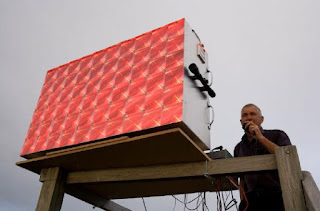 |
| The 60 LED TX array courtesy: REAST |
Earlier long-haul tests out to 209 km used the digital JT65 mode for signal decodes but the 288 km test used a fairly esoteric weak signal mode called WSC built on the Spectrum Lab software. This mode is capable of digging almost 20 db deeper into the noise than JT65, down to almost -50db.
An in depth description of the two long-haul events, including equipment schematics, can be found in "288 km Cloudbounce from Tasmania to the Australian Mainland" and in "209 km with Narrow Beamwidth Transmitter".
The 288 km crossing project evolved over several years and is all very well documented, from the first early steps, at the Radio and Electronics Association of Southern Tasmania's (REAST) website here.
This adventuresome project was largely the work of VK7MO, VK7JG, VK3HZ and VK7TW. Their work is most inspiring and much can be learned from seeing what they discovered when transmitting into the cloudy nighttime skies.
Such an endeavour as this makes the local, much shorter Georgia Strait crossing, seem like a cake-walk, but I can't imagine using anything that big and bright here without causing trouble ... it would probably appear much too 'laser-like' to talk one's way out of a jam. Pointing anything resembling a laser light into the air these days is simply begging for trouble.
I can however, envision a scaled-down version, perhaps consisting of an array of four Luxeons ... at least on my end of the path, but even pointing one of those from the city could be problematic. Perhaps any NLOS lightwave attempts across Georgia Strait will need to be well away from Vancouver and its two-million sets of eyes.
 VE7CNF’s Lightwave Cloubounce / Scatter Tests
VE7CNF’s Lightwave Cloubounce / Scatter Tests

After our recent lightwave CW QSO, described here, Toby (VE7CNF) has been re-focusing on refining his lightwave system for weak signal non-line-of-sight (NLOS) cloudbounce and scatter mode experiments.
His testing to date has been limited to within his own suburban yard, with the transmitter being set up on the south side of the house and the receiver set up on the north, while basically pointing things straight up.
Several tests have already been done with exciting results, including audible CW being returned from a low (5,000') cloud ceiling and weaker returns noted on clear air scatter but readily detected in the CW QRSS mode. Toby has also interfaced his PC audio, via amplifier and FET driver, to enable him to use WSPR and JT9 modes, resulting in positive signal returns using these two digital modes of modulation.
Toby described some of his results and methodology in a recent e-mail updater:
I've done some lightwave backscatter experiments this last week. The transmitter is on my front deck, pointed straight up as verified using a level across the lens end of the box. The receiver is in the back yard and pointed up also. Between the two, the house is about 30ft high and blocks any direct light.
Last night May 8 UTC was clear and I was getting a QRSS10 level signal with the receiver pointed at elevations from 70 to 85 degrees, through the transmitter beam. There was nothing received from straight up, so the clouds were too high for cloud backscatter. At 80 degrees elevation I got the best signal. I've attached an Argo screen grab of QRSS10 (FSK CW with the 570 Hz tone as key-down).
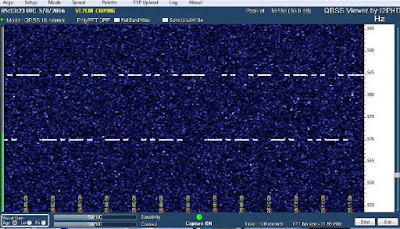 |
| QRSS10 CW clear air scatter return signal |
WSPR2 was decoding consistently and JT9 was about 70%. I tried JT65, BPSK31, and MFSK8 but the SNR was too low for those to work.
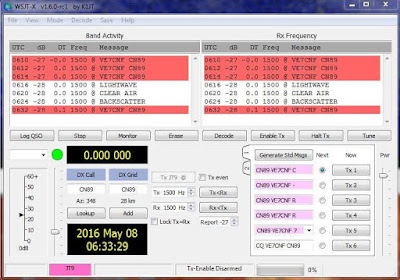 |
| JT9 cloudbounce return signal 14,000 - 24,000 FT |
May 8, 2016 UTC CYVR clouds and temperature/dewpoint data:
0500 FEW CLOUDS (1/8 - 2/8) 14000 FT, SCATTERED CLOUDS (3/8 - 4/8) 24000 FT, 14 C / 11 C
0600 FEW CLOUDS (1/8 - 2/8) 14000 FT, SCATTERED CLOUDS (3/8 - 4/8) 24000 FT, 14 C / 9 C
0700 FEW CLOUDS (1/8 - 2/8) 12000 FT, FEW CLOUDS (1/8 - 2/8) 22000 FT, 13 C / 7 C
... I'll try CW and digital again when there's some lower cloud conditions. That’s tough to get without rain at the same time.
I did get dew on the receiver last night, so I'll be adding heating resistors inside the boxes to keep the lenses warm. Electric heating has worked great to keep dew off the optical surfaces of my telescope. I'll also look at adding shrouds to shield the lenses from the cold sky.
More from May 15th:
Last night was good for backscatter from low clouds, at 1300 to 1900 ft according to airport weather. I had to stay up late though, as the cloud didn't move in until midnight.
I've attached a couple of CW recordings. Early on the signal was weaker with QSB. Later it was strong and solid.
I've also attached a screen grab of WSPR2. Signals were up around 0dB this time.
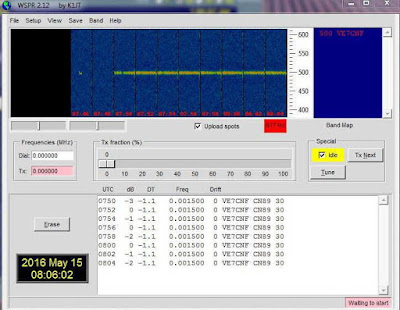 |
| WSPR cloudbounce return signals 1300 - 1900 FT |
I played with a bunch of digital modes and FMHELL and SSTV. Everything was working pretty well off the clouds.
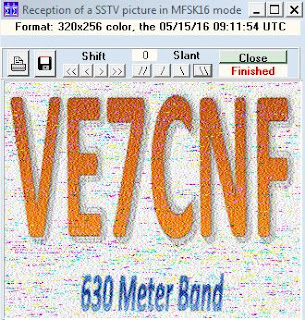 |
| SSTV cloudbounce return signal |
The nextstep is to move the rx farther from home, then to try sending signals over to John or Steve by cloud bounce.
Toby's nearest lightwave neighbour, VA7MM, is in mid-build and is working to complete a system capable of running overnight cloudbounce / scatter tests between their two respective backyards ... the NLOS distance is about 15 km. Although the path includes some bright commercial lighting QRM, with narrow-band modes such as QRSS or WSPR, it may not be a problem. I suspect one of the biggest problems will be getting suitable weather as, here on the west coast, dense clouds usually turn into rain very quickly, especially near the coastal mountains where Toby and Mark are located.
I find Toby's results to be both encouraging and exciting! It will be interesting to try some cloudbounce between their respective stations and my own and maybe hopping the NLOS path across cloudy Georgia Strait. It may well be possible to do this in one of the quicker QRSS CW modes such as QRSS3 or QRSS10, both of which can have fairly fast exchanges of the required information (calls, signal report and final confirmations). Failing that, slower QRSS30 or one of the weak signal digital modes such as JT9 / WSPR which have the ability to dig deep (-30db) into the background noise may be the answer ... there is much to learn yet!
 A Second West Coast Lightwave Adventure
A Second West Coast Lightwave Adventure
 |
| 51km Path courtesy: https://www.google.ca/maps |
Toby, VE7CNF, successfully inaugurated his lightwave station earlier this week, on Monday night, completing a nice two-way CW contact between West Vancouver (CN89) and Mayne Island (CN88). The distance spanned was approximately 51km (32 miles), crossing atop the western edges of Vancouver and then across the Strait of Georgia, the body of water separating mainland BC from Vancouver Island.
The details of Toby's homebrew lightwave equipment are described on his web site here and are similar to the station at this end ... also described in earlier blogs. This was the same path covered in my two previous lightwave QSO's with Markus, VE7CA, described here.
Monday evening's weather was clear and calm but at this time of the year, true darkness is a long time coming. With a full-moon just a few nights away, the sky never did get very dark it seemed. I set up my end of the path late in the afternoon, just in front of the house.
VE7CNF/7 end showing the busy-looking site in operation.
Accompanying Toby to the mountain lookout location were VA7MM, his YL VA7MAY and Markus, VE7CA who initially scouted out and found this nice site for our original lightwave contacts. Thanks to Markus who snapped a picture of the diehard lightwave crew!
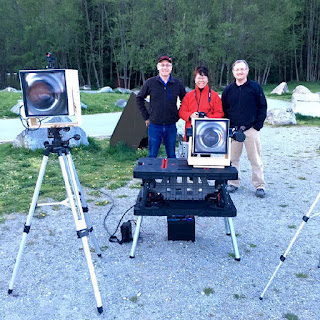 |
| VA7MM, VA7MAY and VE7CNF |
Although Toby's signal was very strong, the lighting hum was strong enough to cause some receiver front-end desensing and slightly modulate Toby's CW signal with a touch of AC ripple. I did not notice this hum when working VE7CA at the same location a couple of years ago. It's possible that there was no snow on the ski-hill at the time and the lights were not turned on.
Moving the receiver just a few degrees to the west made a huge difference, as the hummy background noise level returned to the quiet hush of a dark sky.
Toby's recording of my signal is much cleaner as there are no bright lights when looking towards Mayne Island. It is really interesting to hear the rapid fading, almost a flutter, on my CW signal, as the light passes through various levels of ever-changing haze above the water.
Midway through our one hour QSO, Toby reported that my signal had dropped measurably as had his signal on my end. Although I could see no obvious clouds in the path, I did notice a red glow out in the Strait that had not been there earlier. When I turned off my transmitter, the glow disappeared, indicating that there was indeed some low level haze that had crept up on us, and enough to cause some signal absorption on the path. Thankfully signal levels returned to normal, and actually were a bit stronger, about fifteen minutes later, when the haze thinned and the skies had grown a little darker.
Towards the end of our QSO, I had the chance to test out my #2 receiver. It was built so that I could do some NLOS cloudbounce testing here on the island, without having to separate my main system's transmitter/receiver pairing. At the time, there were no lenses available from the overseas manufacturer, so my quest for a suitable lens led me to a local 'bargain style' hardware importer (Princess Auto), who had a good supply of $5 lenses. The lens seemed to function well in my local tests but it had never been put side-by-side with the higher quality lens in my main transceiver. As it turned out, the $5 lens worked very well, easily detecting the 51km signal although it didn't sound quite as loud since the receiver I built for it was intended to interface with my laptop and lacked the additional audio amp I had built for the main system.
A final interesting observation was made, when on a whim, I placed a large cardboard shield over the bottom quarter of the transceiver's receiver lens. The signal strength didn't appear to change at all. I gradually blocked more and more of the lens but astonishingly, was still able to copy Toby's CW with all but a 1" strip of the lens completely covered! This would tend to indicate that we would be able to communicate with a very much smaller Fresnel or optical glass lens, such as a 4" or even a 2" inch magnifier. As I commented to Toby on CW, the possibilities for experimentation are endless.
All-in-all it was a very successful evening and the mountain-top gang seemed to enjoy the outing as much as I did, and ... the QSL is in the mail.
Hopefully there are other VE7's in or around Vancouver that might be interested in throwing a signal over this way some night ... I'll leave the light on for ya!
 Local Lightwave Activity / A New 630m Resource Site
Local Lightwave Activity / A New 630m Resource Site
 |
Toby, VE7CNF, has sent me some mail indicating that his new lightwave system is ready for a two-way test!
His system is very similar to the ones built and deployed by myself and Markus, VE7CA, in late 2013. The culmination of that activity is described here, in 'On Making Nanowaves - Part 6'. Our lightwave QSO and homebrew gear were later described in a 'how to' article in the 'The Canadian Amateur' as well as in the newest edition of 'The Radio Amateur's Handbook' (2016).
Toby describes his most recent pre-QSO backyard testing:
The lightwave gear appears to be working well. Focus looks good and the
finder scopes are doing their job. There's a reflective sign high up on a
hydro tower 170 meters away that's handy for testing. It lights up bright
when the transmitter's on it.
Back scatter off the clouds above my house worked too. I heard my CW beacon, audible 339, off a patch on the clouds about 1 degree wide. I don't really know if it was clear air scatter from closer by, or scatter off the clouds, but the spot was small. That's with the tx on the front deck, and rx in the back.
I used Spectran to check the noise from city lights in my area. At QRSS10
speed there are spectral lines at 540, 600, and 660 Hz. They aren't too
strong, but those are some frequencies we should avoid.
 |
| VE7CNF's lightwave system - TX (L) & RX (R) |
Hopefully the weather will co-operate enough to allow us to make a two-way QSO later this week. Plans call for Toby to set up near the same location in West Vancouver used by VE7CA as it offers a clear LOS path to Mayne Island, 54km to the southwest.
 |
| 54km Georgia Strait crossing (courtesy: https://www.google.ca/maps) |
*****************************************************
Rik, ON7YD, has set up a new website devoted to information specific to 630m. His 472kHz.org site looks as if it will be a valuable resource for those looking to get information and a start on our new band. At present, there is some really great information regarding transmitters, antenna systems and calculating E(I)RP levels. Have a look!
 More VE7 Lightwave Activity
More VE7 Lightwave Activity
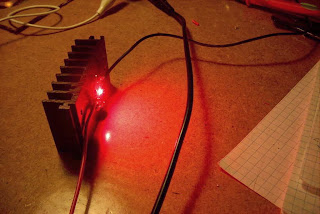 Two more VE7's are well on their way to getting in on the lightwave fun in the Vancouver lower mainland region. Toby, VE7CNF, and Mark, VA7MM, are constructing stations similar to the ones built by myself and Markus, VE7CA.
Two more VE7's are well on their way to getting in on the lightwave fun in the Vancouver lower mainland region. Toby, VE7CNF, and Mark, VA7MM, are constructing stations similar to the ones built by myself and Markus, VE7CA.Toby and Mark live close enough that a clear-air scatter QSO between them might also be a possibility. Having another near-by amateur, or even in the same city, is a great source of motivation ... not to mention having someone else to actually talk to, once the system has been built.
Except for the LED focusing sled, Toby's fine-looking transmitter box and LED driver / modulator, are now complete. The receiver is next on the list. I believe this will use one of the inexpensive ($5) fresnels lenses, purchased locally at Princess Auto, that seems to work very well for the price.
| photos courtesy VE7CNF |

